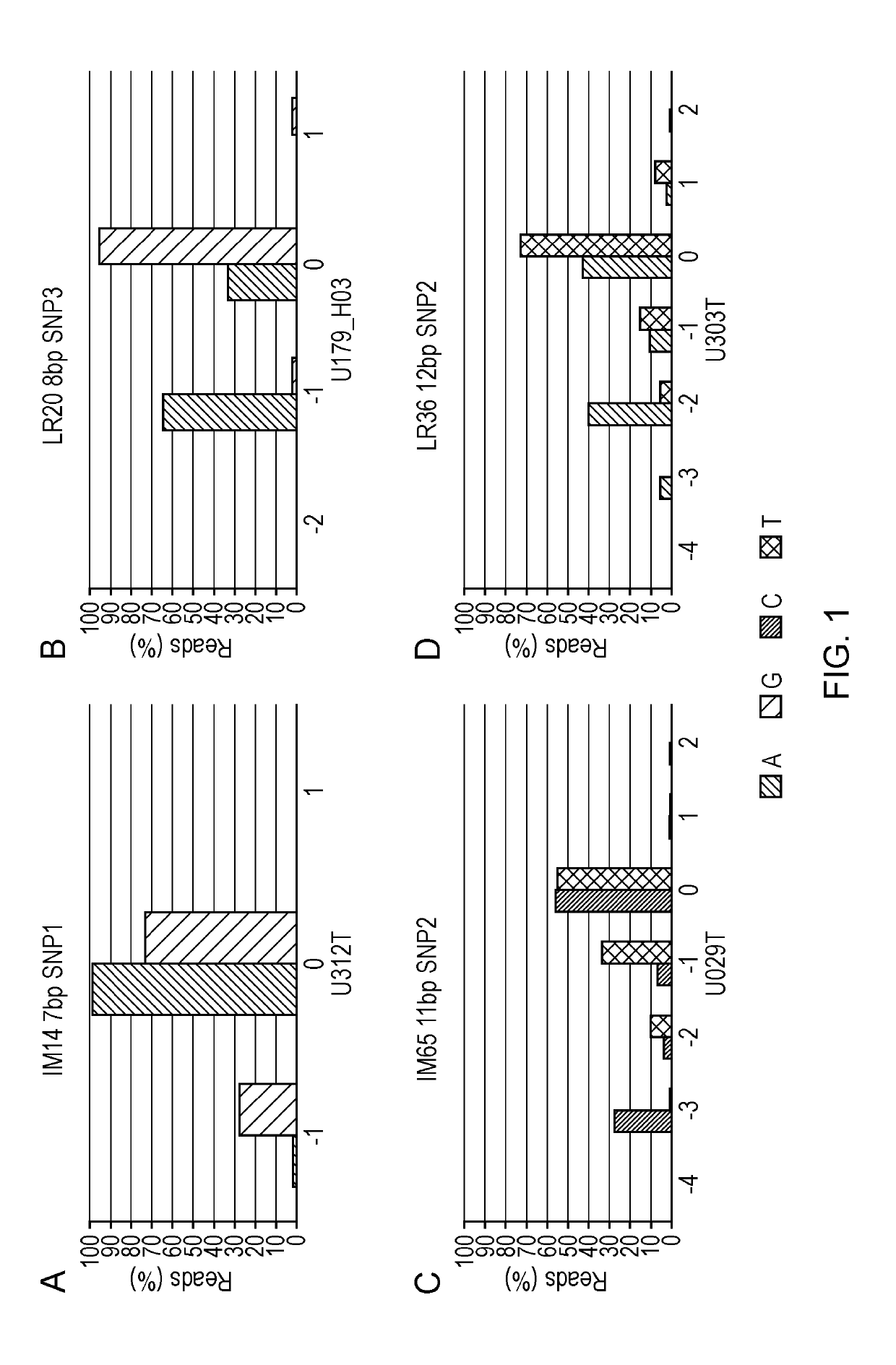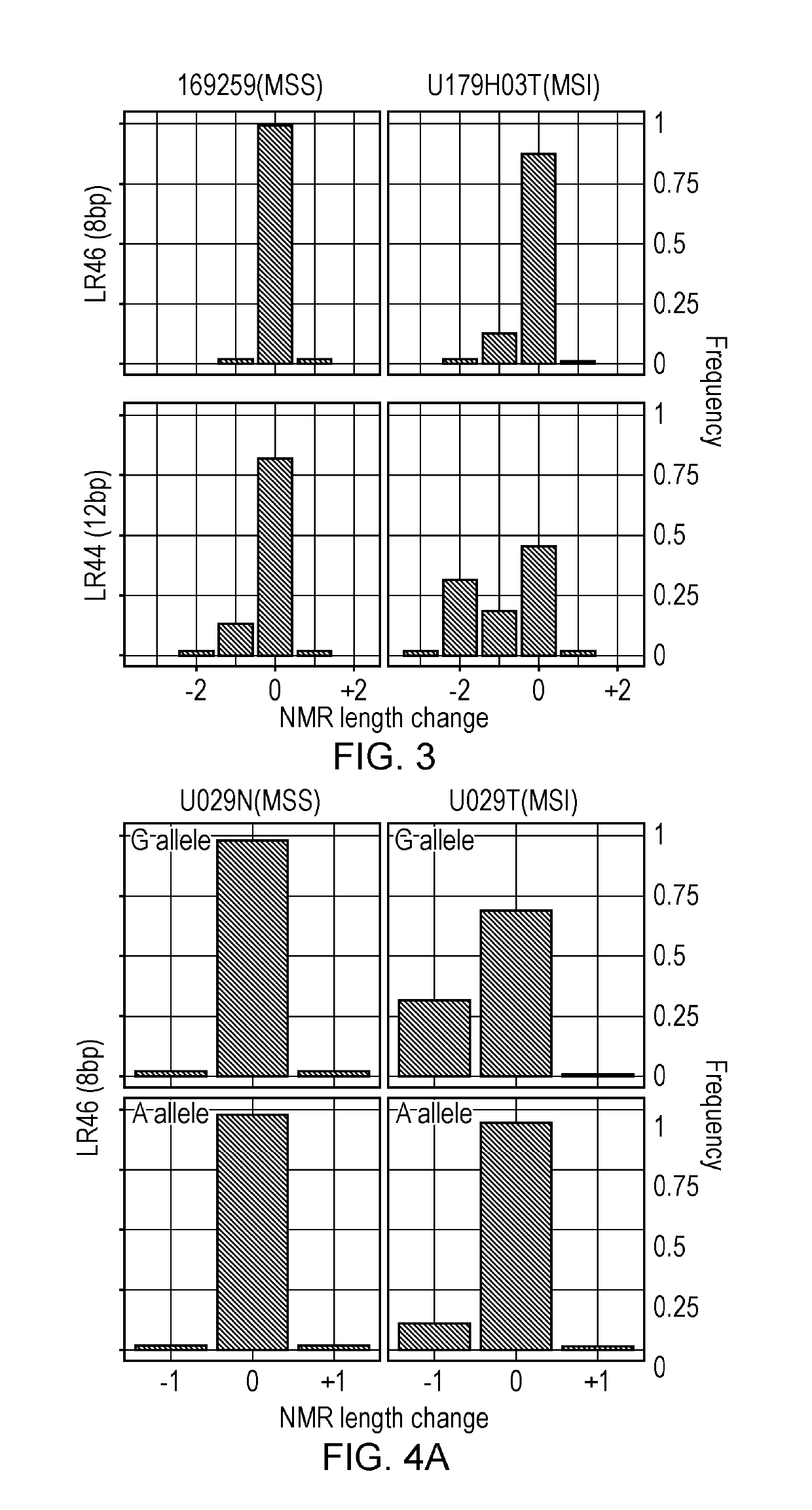Methods of Identifying Microsatellite Instability
a microsatellite and instability technology, applied in the field of methods of identifying microsatellite instability, can solve the problems of microsatellite instability (msi), microsatellite instability has been observed in some tumors, and the length of microsatellite instability is known to be unstable, and achieves high levels of microsatellite instability
- Summary
- Abstract
- Description
- Claims
- Application Information
AI Technical Summary
Benefits of technology
Problems solved by technology
Method used
Image
Examples
examples
[0147]The examples describe how genome wide analysis of instability in CRC tumours was used to identify unstable short microsatellites. Particular focus was given to identifying repeats linked to high frequency SNPs to facilitate deconvolution of sequence error and instability. One hundred and twenty 7-12 bp markers were identified. The inventors then assessed the panel of one hundred and twenty 7-12 bp markers defined by this screen for sequence based typing. The initial 120 of the identified mononucleotide repeats were analysed on a small panel of tumours in two studies to confirm that these repeats could be used as markers for identifying MSI. The first study identified a panel of 18 repeats that were particularly informative (Example 1). The second study focused on repeats of short length (7-9 bp) and identified 8 additional markers that were particularly informative. These 8 markers were combined with the most informative 9 markers of example 1 to generate a new 17 marker panel...
example 1
Selection of a Panel of Mononucleotide Repeats Prioritising Short Repeats
[0151]To investigate the stability or variability of short mononucleotide repeats in tumours with mismatch repair (MMR) defects at the genome level, whole genome sequence data from MSI-H colorectal cancers was mined to identify new homopolymers that are highly variable in MSI-H tumours.
[0152]A total of 218,181 variable 7-12 bp homopolymers were identified from the whole genome analysis. 216495 A / T mononucleotide repeats with indels (insertions or deletions) were identified, but only 1686 C / G mononucleotide repeats. Finding more unstable A / T mononucleotide repeats than G / C mononucleotide repeats is consistent with data reported in cell lines by Yoon et al. (2013). To validate specific repeats for MSI detection, some of the most unstable homopolymers identified in the whole genome analysis were selected for further analysis. The list of 218,181 variable 7-12 bp homopolymers was narrowed down by filtering for repe...
example 2
Selection of an Alternative Panel of Mononucleotide Repeats
[0193]In parallel with the study described in Example 1, a second study was performed to assess and analyse the 120 7-12 bp markers shown in Table A for their potential use as sequence typed MSI markers. This second study initially focused on shorter markers (7-9 bp).
[0194]A batch of 25 short (7-9 bp in length) mononucleotide markers were tested using a cohort composed of 55 CRCs to identify the most informative markers among them. Eight markers were found as the most informative in terms of discrimination between MSI-high (MSI-H) and microsatellite stable (MSS) cases (GM9, GM11, GM17, LR20, LR24, LR49, IM16 and IM66—data not shown). To establish a system for calling instability, these 8 markers were combined together with the nine most informative markers of the panel in Example 1 (i.e. DEPDC2, AP003532_2, GM07, GM14, LR11, LR36, LR44, LR48 and IM49, all 8-12 bp in length) and were tested across a large cohort composed of 1...
PUM
| Property | Measurement | Unit |
|---|---|---|
| Time | aaaaa | aaaaa |
| Time | aaaaa | aaaaa |
| Time | aaaaa | aaaaa |
Abstract
Description
Claims
Application Information
 Login to View More
Login to View More - R&D
- Intellectual Property
- Life Sciences
- Materials
- Tech Scout
- Unparalleled Data Quality
- Higher Quality Content
- 60% Fewer Hallucinations
Browse by: Latest US Patents, China's latest patents, Technical Efficacy Thesaurus, Application Domain, Technology Topic, Popular Technical Reports.
© 2025 PatSnap. All rights reserved.Legal|Privacy policy|Modern Slavery Act Transparency Statement|Sitemap|About US| Contact US: help@patsnap.com



